In fall 2009, 20 students became pioneers of Princeton University's Bridge Year Program. They journeyed across the world to spend nine months before their freshman year doing community service work, learning new languages and experiencing cultures and customs unknown to them.
Today, those students are young alumni one year out of Princeton whose experiences on campus and paths after graduation were influenced by their participation in Bridge Year. Of the inaugural Bridge Year students, six Class of 2014 graduates — Leah Bushin, Cole Freeman, Lelabari Giwa-Ojuri, Brian Reilly, Shaina Watrous and Chhaya Werner — share their stories below.
"It has been a great pleasure to see returning Bridge Year participants build upon their time abroad when they return to campus," said Bridge Year Program Director John Luria. "And now, as our inaugural participants have graduated from the University and moved on to careers beyond FitzRandolph Gate, it's incredibly exciting to see the various directions they've taken and to think about where their paths may lead."
Nearly 150 Princeton students have participated in the tuition-free Bridge Year program since its inception. Bridge Year also has expanded to accommodate more students in new locations.
During the 2015-16 academic year, 35 incoming freshmen will begin their Princeton experience at Bridge Year locations in Bolivia, Brazil, China, India or Senegal.
"Through Bridge Year, Princeton students have an opportunity to examine both themselves and the world around them from a new perspective," said Luria. "Living abroad and working with local community service organizations certainly pushes students outside of their comfort zones. At the same time, it provides a chance to explore and reconnect with the joy of learning. From what I have seen, Bridge Year has served as an uncommonly special way to begin one's time at Princeton."
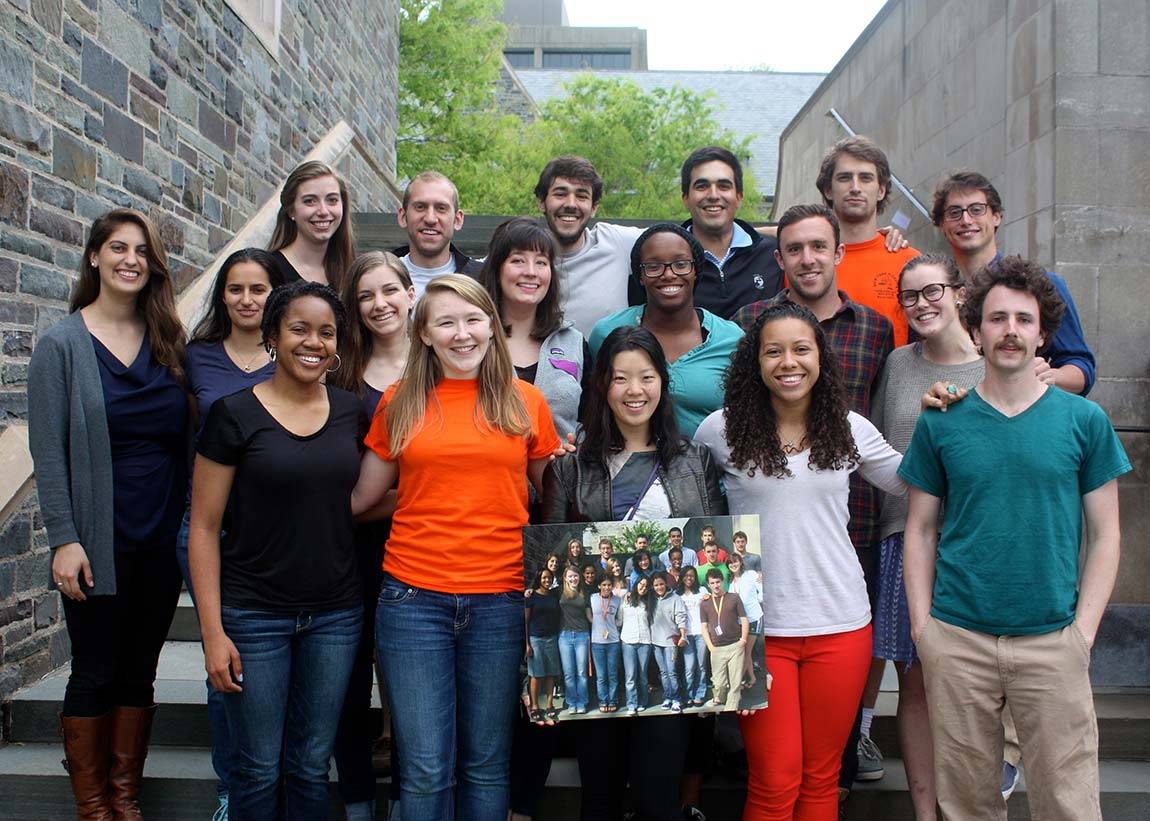
The first group of students to participate in the University's Bridge Year Program are now young alumni one year out of Princeton. The tuition-free program allows students to do community service work abroad before their freshman year. Here, the group holds a photo of themselves taken before they embarked on their Bridge Year journeys during the 2009-10 academic year. (Photos courtesy of Bridge Year Program and the individual students)
Leah Bushin
What was your Bridge Year experience?
I participated in the Bridge Year Program in Peru. I worked on service projects in the field of sustainable development, ranging from installing cleaner-burning stoves and water filtration devices to teaching arts at an afterschool program.
What did you study at Princeton?
I majored in chemistry.
Where are you today?
I am at Princeton beginning my graduate studies. I work as a researcher in the laboratory of Mohammad Seyedsayamdost, an assistant professor of chemistry, and this fall I will begin my graduate studies under his guidance. My research entails both the discovery and biosyntheses of natural products. As a member of Professor Seyedsayamdost's team, I contribute to unraveling the chemical language involved in microbial behaviors and interactions, including bacterial pathogenesis, and in the process, uncovering nature's biosynthetic capacity. The hope is that our work will lead to new drugs, such as antibiotics.
How did Bridge Year influence your Princeton experience?
My Bridge Year experience gave me the confidence to find and pursue my passion at Princeton. It instilled in me a deep desire to discover and explore.
How did Bridge year influence your life after graduating?
Bridge Year has influenced my life immensely. It was through many of the experiences that I had in my Bridge Year that I realized that I could have a real impact on the world, but in order to do so, I had to become a true expert in whatever field I chose to pursue. I am pursing my passion, which is chemistry, and gaining as much training as I can in my particular area of interest. While pursuing my projects in the laboratory, I do think about the impact that our work could have in addressing the major global health challenges our world faces today, including antibiotic resistance. The experiences that I carry with me from Bridge Year remind me that although I work in the laboratory, and not in the "field," the research I do has the potential to impact real lives.
Are there lessons from Bridge Year you use in life today?
Bridge Year helped instill in me a drive to discover, explore and learn intensely about the world around me. This drive fuels and shapes my research efforts as a chemist on a daily basis.
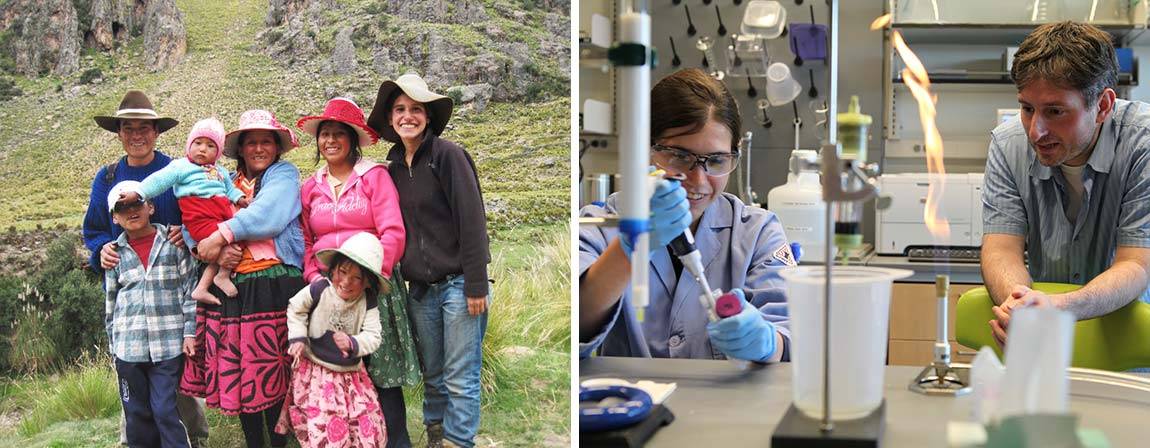
Left photo: Class of 2014 graduate Leah Bushin (far right) spent her Bridge Year in Peru, where she worked on service projects in the field of sustainable development. Right photo: She has remained at Princeton after graduating last year to work as a researcher in the laboratory of Assistant Professor of Chemistry Mohammad Seyedsayamdost (right).
Cole Freeman
What was your Bridge Year experience?
I participated in the Bridge Year Program in Ghana, with my time split between two locations: Accra, the capital, and Oguaa, a small village about an hour east of Kumasi, the country's second largest city. In Accra, I worked with Self-Help Initiative Support Services, a small nongovernmental organization that works in one of the city's most desperate slums. In Oguaa, I was an assistant teacher at a local middle school.
What did you study at Princeton?
I majored in French language and literature. I also took courses in African studies as well as a variety of other subjects — math, computer science, Swahili and other languages.
Where are you today?
I am an apprentice on a small organic vegetable farm in western North Carolina. I came here in early April and will be living and working on the farm through the growing season, until October or November.
How did Bridge Year influence your Princeton experience?
My Bridge Year experience had an enormous and enriching impact on my time at Princeton; it helped to shape the course of all aspects of my Princeton education, including my academic trajectory, my social life and my extracurricular activities.
Throughout my four years at Princeton (and through to the present), I was a part of an extraordinary group of like-minded students who were passionate, engaged and profound in thought and action. We have been through similar experiences even if in very different regions of the world, and we value many of the same things: personal growth and learning, adventure, trying to help others and be better in the world. As I was already connected to this group when entering as a freshman, these people influenced and inspired me from the beginning, providing a social outlet as well as an intellectual one.
How did Bridge year influence your life after graduating?
I think the biggest way that Bridge Year has affected me since graduating — and has affected me more broadly speaking, in my life generally — is that it has made me more willing to take risks in the conventional sense, to see my life not as an inexorable, burdensome march from one pre-established milestone to another but rather as a journey, an adventure that may take me to many places during its often whimsical course.
Are there lessons from Bridge Year you use in life today?
Most of all, I still strive to live life as if it were Bridge Year — that is to intentionally challenge oneself, to never stop exploring, to continue learning from and connecting with others no matter how different they may seem to be. During Bridge Year I came to understand what is involved in the continuous and relentless pursuit of being a good, wholesome, beneficial being on this earth — I am still engaged in this pursuit and expect I always will be.

Left photo: Cole Freeman spent his Bridge Year in Ghana, where part of his work included volunteering as an assistant teacher at a middle school in the village of Oguaa. Right photo: Freeman is currently an apprentice at a small organic vegetable farm in North Carolina.
Lelabari Giwa-Ojuri
What was your Bridge Year experience?
I was based in Serbia. I spent half the program in the city of Novi Sad working at the Yugoslav Youth Association against HIV/AIDS and the other half in the city of Niš working at the Club for Youth Empowerment.
What did you study at Princeton?
I was a politics major and earned a certificate in Near Eastern studies.
Where are you today?
New York City. I have a Princeton Project 55 Fellowship, which offers recent Princeton graduates the opportunity to work in nonprofit organizations around the United States.
I work at the Center for Alternative Sentencing and Employment Services (CASES). As a court representative in the Bronx Supreme Court, I work with youth ages 16–24 with felony charges who are facing a prison sentence. I identify individuals who are eligible for our youth development program, which provides education, employment, clinical and legal services as an alternative to incarceration.
How did Bridge Year influence your Princeton experience?
Academically, I applied to Princeton with an interest in post-conflict peace-building in the Middle East, and left Bridge Year with a complementary passion for post-conflict peace-building and grassroots movements in the Balkans.
I took a number of classes on the Balkans and studied Bosnian-Croatian-Serbian along with Arabic. My senior thesis was on the evolution of grassroots women's organizing in Bosnia since the Communist era. I also returned to Serbia twice during my time at Princeton. I worked one summer at the Gay-Straight Alliance in Belgrade through the International Internship Program and I traveled to the Balkans my sophomore year for a two-week tour of interfaith peace-building initiatives sponsored by the Office of Religious Life.
How did Bridge year influence your life after graduating?
Bridge Year helped motivate me to not go straight to graduate school after leaving Princeton, and instead spend time working in the nonprofit and public sector. While I'm currently working on domestic matters, I'm still very interested in Balkan politics and hope to visit soon.
Are there lessons from Bridge Year you use in life today?
Every year, I never could have predicted where I'd be or what I was doing. Bridge Year helped give me the peace of mind to take chances and to embrace unexpected opportunities, relationships or learning opportunities. I came away from my Bridge Year experience with a greater understanding of my strengths, what I struggle with and areas I need to grow. It was really humbling and disorienting to be so constantly confused and lost for so long.
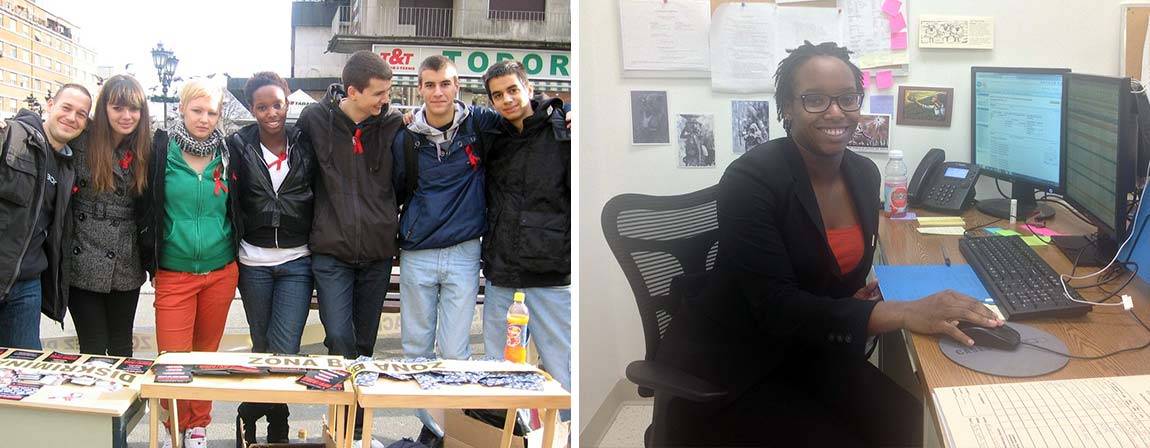
Left photo: Lelabari Giwa-Ojuri (center) spent her Bridge Year in Serbia, where part of her work included volunteering at the Yugoslav Youth Association against HIV/AIDS. Right photo: Today, she works at the Center for Alternative Sentencing and Employment Services in New York City.
Brian Reilly
What was your Bridge Year experience?
I was based in Urubamba, Peru. My community service work with ProWorld Peru involved the areas of health and the environment.
What did you study at Princeton?
I majored in the Woodrow Wilson School of Public and International Affairs and earned certificates in Latin American studies, Spanish language and culture, and French language and culture.
Where are you today?
San Juan del Sur, Nicaragua. I work for the nonprofit organization Comunidad Connect on a Princeton-in-Latin America fellowship. I am part of the organization's Nica Agua clean water project. We deliver filters to communities so people stop getting sick from parasites or bacteria in their water. I also am our team's communications person, taking photos and writing stories for our blog, Facebook and Instagram pages.
How did Bridge Year influence your Princeton experience?
The same interests that led me to Bridge Year guided my choices in study. Bridge Year may have strengthened them, or made me a more informed contributor in classes.
Socially, Bridge Year impacted me most greatly. I feel that I grew up almost as much in the nine months I spent on Bridge Year as in the time I spent at home, so it was a disproportionately dominant influence on my perspective by the time I arrived at Princeton.
Bridge Year also taught me that with the right amount of empathy, you can overcome any barrier of language, nationality, race, socio-economic class, culture, etc., and connect with anyone. This lesson made me always eager to get to know others.
How did Bridge Year influence your life after graduating?
Bridge Year infected me with a love of adventure and exploration. Along the same lines, Bridge Year made me feel that I could go anywhere and be fine. One way or another I would figure it out. I learned enough about evaluating risks, dealing with unknowns, and about myself that I felt that I could stay safe and find happiness one way or another. That feeling is enormously empowering. I can't stop running off to new places.
Are there lessons from Bridge Year you use in life today?
Bridge Year changed my perspective immeasurably. It was the first time I met people to whom I looked up greatly that had completely different life paths from my own. In my privileged suburban American bubble I found myself defining a successful life very narrowly: work very hard in high school and be good to others so that you get into good college and do the same so that you get a good job to ensure the financial security that will give your family the greatest chances for a similarly "successful" life.
In Peru, I met many Peruvians and others, including my fellow Bridge Year Peru participants, who were on very different paths, yet seemed to be leading very meaningful and satisfying lives. I was drawn to them, and then inspired by them upon getting to know them better. The experience taught me that there are a million and one good ways to live, and no one way is necessarily better than any other. It has made me more humble about the value of my own life path, curious about those of others and hesitant to judge any. This broadened perspective on life choices has leaked into my calculus regarding almost everything. It's nearly impossible for me to see things in black and white since Bridge Year.
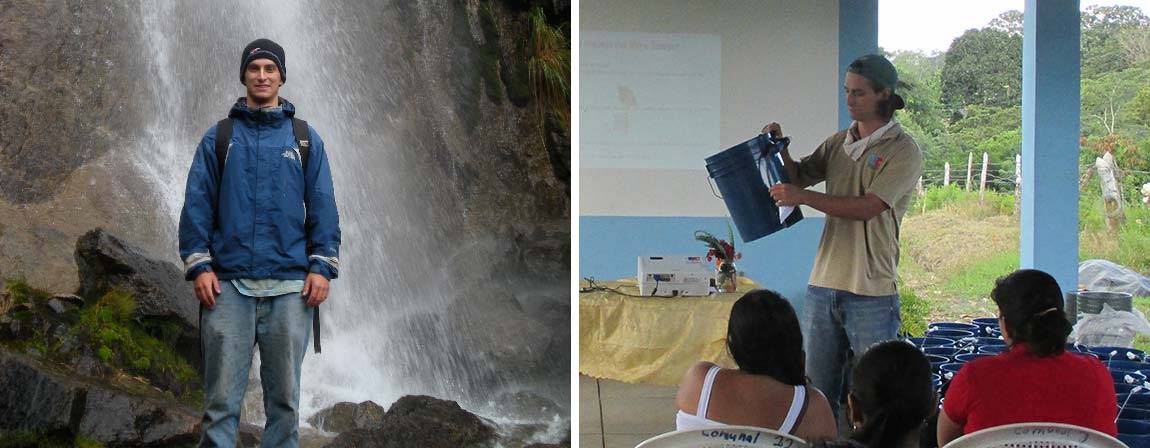
Left photo: Brian Reilly spent the 2009-10 academic year in Peru through Princeton's Bridge Year Program. Here he is hiking in a forest below the Chicón glacier, located outside of the town of Urubamba. Right photo: Today, the Class of 2014 graduate is based in Nicaragua working for the nonprofit organization Comunidad Connect's clean water project.
Shaina Watrous
What was your Bridge Year experience?
I lived in Varanasi, India. I worked for Guria Sansthan, an organization that fights human trafficking and exploitation through a number of different methods. Guria also runs a non-formal education (NFE) center for the children who live in the city's red light area. I split my time between the NFE center and working in Guria's office on grant writing.
What did you study at Princeton?
I majored in the Woodrow Wilson School and earned certificates in African American studies and South Asian studies.
Where are you today?
I live in Washington D.C., where I work as a regional field manager for the Petey Greene Program. The organization builds connections between universities and local departments of corrections, helping to facilitate meaningful educational programming for incarcerated people. We recruit, train and coordinate volunteers from universities to work as supplemental tutors for education programs in prison.
I was a tutor with the Petey Greene Program all four years at Princeton, which is where the program originally began. When I returned to Princeton after Bridge Year, I was looking for some kind of service that I'd feel committed to and found it in the Petey Greene Program. Bridge Year gave me the motivation and confidence to volunteer as a tutor for people in prison.
How did Bridge Year influence your Princeton experience?
It's hard to imagine what my experience at Princeton would have been without the Bridge Year Program. I think it would have been significantly less meaningful.
Before Bridge Year, service was something that I thought people did in their free time — after work, after class, as some kind of nonessential supplement. But that whole conception of service changed on Bridge Year. Working at Guria, I was exposed to people who risk their lives every day to save the lives of the most vulnerable, exploited members of society. I saw how that kind of passion for service could be your whole life.
I can't tell you how important it was for me to have had this experience before I started college. It was so grounding to have known these true heroes. At Princeton, it can be easy to get caught up in the stress of finishing a paper or joining an eating club — whenever I felt overwhelmed by these relatively small things, I'd return to that perspective I gained on Bridge Year.
In particular, my experience inspired me to work with fellow Bridge Year students to create the documentary "Specks of Dust" about Guria and its leaders, Ajeet Singh and his wife Manju. I was in a documentary filmmaking class in fall 2012, and the professor told us that key to a successful documentary was choosing the right characters. I immediately thought of Ajeet and Manju. So in the summer of 2013, after getting a generous grant from the Davis Projects for Peace, I returned to India with Azza Cohen, a former Bridge Year student in the Class of 2016. We worked with another former Bridge Year student, Katie Horvath from the Class of 2015, to film a documentary that told the story of Guria's leaders' sacrifice and hope.
My time in India helping to advocate for human rights also affected my course of studies at Princeton. My favorite class at Princeton was a politics course on human rights. I also studied abroad in Cape Town, South Africa, in the spring of my junior year, where I studied the provision (or lack thereof) of early childhood education to children in historically marginalized communities.
How did Bridge Year influence your life after graduating?
My Bridge Year experience came full circle last month when our documentary "Specks of Dust" premiered on campus, and Ajeet and Manju traveled from India for the event.
The premiere was a completely surreal experience for me. All of these important elements of my life had converged in one theater. Former Bridge Year students, Princeton administrators, professors, my co-workers, family members and the Guria family were all there. Ajeet was shaking hands with Princeton's president, Christopher L. Eisgruber, and Manju was talking to my mom. It felt like a grand finale to my time at Princeton.
Are there lessons from Bridge Year you use in life today?
In my role with the Petey Greene Program, part of my responsibility is to ensure a positive and meaningful experience for the volunteers tutoring inside the prison. Bridge Year made me mindful of how important it is for volunteers to be self-reflective, in terms of one's intentions and impact.
For me, Bridge Year involved a lot of self-reflection about being humble in terms of my potential impact, and the necessity of my service. Too often, volunteers with good intentions can recklessly assume they know what's best, and end up being at best unhelpful, and at worst harmful. To properly "serve" others, there has to be a collaborative process respectful of the community's needs and goals. That humility was essential to my time on Bridge Year, and will always be a part of my consciousness.
Through Petey Greene, I want to facilitate for my volunteers the kind of reflective experiential learning I had on Bridge Year. I talk to my volunteers about making a tutoring session collaborative, and tailored to the student's individual goals. In working on this, I've definitely drawn from a lot of what made Bridge Year a transformative experience for me.

Class of 2014 graduate Shaina Watrous' Bridge Year experience came full circle this past month. Left photo: Before her freshman year at Princeton, she spent nine months in India working for Guria Sansthan, an organization that fights human trafficking and exploitation. Right photo: In April, Watrous (right) and former Bridge Year participant Azza Cohen (left) premiered on campus their documentary "Specks of Dust" about Guria and its founder Ajeet Singh (center).
Chhaya Werner
What was your Bridge Year experience?
I spent my Bridge Year in Varanasi, India. I worked at a village school, teaching first- through fourth-grade English and science, and fifth- through seventh-grade English. My service work as a teacher defined my Bridge Year more than any other aspect. I won't say my students were angels because they absolutely weren't, but my classes had an incredible mix of enthusiasm, dedication and mischief, and every day with them was both a challenge and a gift.
During Bridge Year, I was continually blown away by the four other Princeton students I shared these adventures with. The support, the laughter the heart-wrenching conversations all raised my experience to places I never imagined when I started this journey. We explored twisting gullies and crammed into rickshaws. We challenged each other to get comfortable with discomfort. We dressed up for weddings together and hiked mountains together. Sometimes we cried together. To this day, they are the people I call when I need someone to have my back, or want to take off on an adventure.
What did you study at Princeton?
I majored in ecology and evolutionary biology, with a focus on plant community ecology.
Where are you today?
I am a first-year Ph.D. student at the University of California-Davis, in one of the biggest ecology programs in the country. I'm working with a pair of inspirational advisers on a project that combines traditional fieldwork with new remote sensing algorithms to understand how climate change will impact forest recruitment after fires.
How did Bridge Year influence your Princeton experience?
My Bridge Year experience helped me become much more comfortable with taking risks, and seeking out new challenges, such as entering Princeton's Integrated Science program my freshman year. This two-year course spanned physics, chemistry and biology with quantitative, computational and lab research methods. The speed of the class and corresponding workload was the biggest academic challenge I have faced before or since.
I continued to take on challenges, or choose paths that were less certain. I joined a graduate student on her first field season in Costa Rica, and learned how to crawl through brush, navigate muddy trails during rainstorms and avoid venomous snakes. I spent a semester abroad in Panama doing my own fieldwork, continuing to push my comfort zone both in my project design and the physical work I carried out. For my senior thesis, I developed a project completely independent from my adviser's work, and made connections with National Park researchers to get the necessary permits and access.
I also continued to teach. I worked for all four years as a tutor to local middle and high school students. My experience in Bridge Year built my patience and skills working with students learning English as a second language.
Overall, the time I spent in India helped me bring a sense of perspective to my school work, an important reminder of life beyond the so-called "orange bubble," and an immense gratitude for how privileged I was to be a student at Princeton. Pushing myself on Bridge Year gave me a sense of confidence to tackle a range of challenges, and to expand my comfort zone even further, in academic endeavors and mud-splattered adventures.
How did Bridge Year influence your life after graduating?
Taking time away from academics during Bridge Year enabled me to then go straight from undergraduate life to graduate school. I have a sense of confidence in my studies and research that comes from knowing no matter how many things I'm juggling, it's still less complicated than the classroom I taught in. I'm also very conscious, as I continue on the path of academia, to connect my work to the things that matter to me: making a positive environmental impact, connecting with communities and sharing my love of learning with students from all walks of life.
Are there lessons from Bridge Year you use in life today?
One huge lesson is to pay attention to the people around me, and listen to them. I grew up in a city where people walk by you without making eye contact. In Varanasi, people will stop you to talk as you walk down the street. I became friends with shopkeepers, students and a vibrant 60-year-old woman who tends the water buffalo. Back in the U.S. I'm working on reaching out to people and trusting them enough to make that connection.
My last big lesson is to say yes to new adventures, projects and ideas. One of my friends wore a shirt in India that said "never stop exploring," and that's a motto I'm continuing to live. I'm so grateful to the Bridge Year Program for all my adventures in India and every year since.
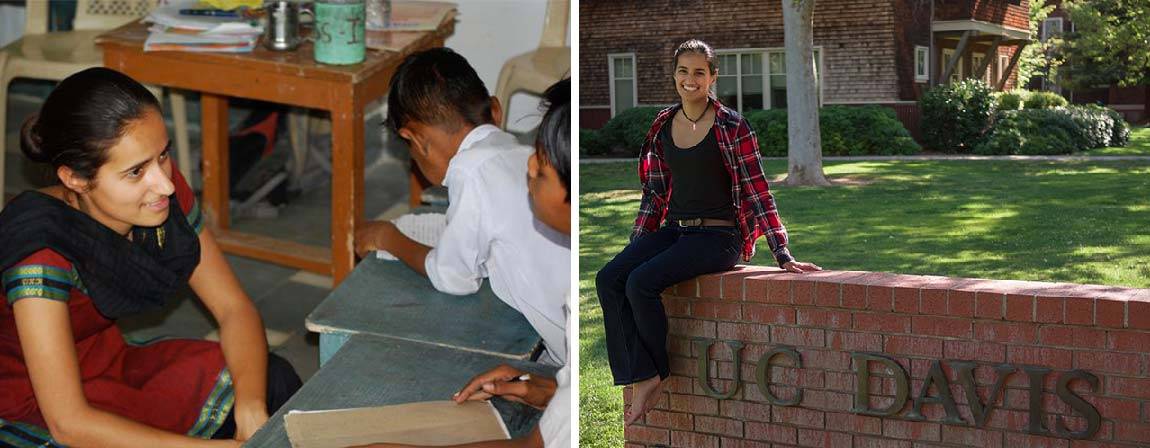
Left photo: Chhaya Werner says her service work as a teacher in India defined her Bridge Year experience, and she continued to work as a tutor to middle and high school students while she was an undergraduate at Princeton. Right photo: Today, Werner is a Ph.D. student studying ecology at the University of California-Davis.
Mary Cate Connors, Office of International Programs, contributed to this story.


